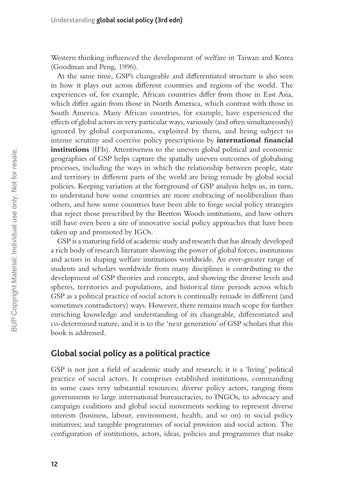BUP Copyright Material: Individual use only. Not for resale.
Understanding global social policy (3rd edn)
Western thinking influenced the development of welfare in Taiwan and Korea (Goodman and Peng, 1996). At the same time, GSP’s changeable and differentiated structure is also seen in how it plays out across different countries and regions of the world. The experiences of, for example, African countries differ from those in East Asia, which differ again from those in North America, which contrast with those in South America. Many African countries, for example, have experienced the effects of global actors in very particular ways, variously (and often simultaneously) ignored by global corporations, exploited by them, and being subject to intense scrutiny and coercive policy prescriptions by international financial institutions (IFIs). Attentiveness to the uneven global political and economic geographies of GSP helps capture the spatially uneven outcomes of globalising processes, including the ways in which the relationship between people, state and territory in different parts of the world are being remade by global social policies. Keeping variation at the foreground of GSP analysis helps us, in turn, to understand how some countries are more embracing of neoliberalism than others, and how some countries have been able to forge social policy strategies that reject those prescribed by the Bretton Woods institutions, and how others still have even been a site of innovative social policy approaches that have been taken up and promoted by IGOs. GSP is a maturing field of academic study and research that has already developed a rich body of research literature showing the power of global forces, institutions and actors in shaping welfare institutions worldwide. An ever-greater range of students and scholars worldwide from many disciplines is contributing to the development of GSP theories and concepts, and showing the diverse levels and spheres, territories and populations, and historical time periods across which GSP as a political practice of social actors is continually remade in different (and sometimes contradictory) ways. However, there remains much scope for further enriching knowledge and understanding of its changeable, differentiated and co-determined nature, and it is to the ‘next generation’ of GSP scholars that this book is addressed.
Global social policy as a political practice GSP is not just a field of academic study and research; it is a ‘living’ political practice of social actors. It comprises established institutions, commanding in some cases very substantial resources; diverse policy actors, ranging from governments to large international bureaucracies, to INGOs, to advocacy and campaign coalitions and global social movements seeking to represent diverse interests (business, labour, environment, health, and so on) in social policy initiatives; and tangible programmes of social provision and social action. The configuration of institutions, actors, ideas, policies and programmes that make
12

